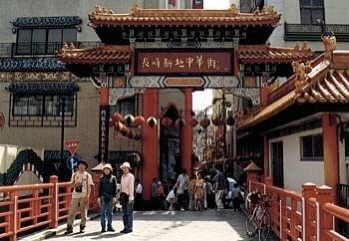

































Having had a good night's sleep, I was ready to explore Nagasaki. First stop: Inasa-yama, the hilltop that you can either cheat (meaning take the cable car up to) or puff up on your bikemobile. Either way, you get this wonderful panoramic view. Supposedly the night view is also great; coming up for the sunset and night view might be one idea. Best not to bike down the road at night, though.
Japan's other port cities of Yokohama and Kobe are famous for their Chinatowns, the former's being quite a bit larger than the latter's. By contrast, Nagasaki itself could be called one giant Chinatown. The city is dotted with Chinese temples and other signs of historical Chinese influence. No wonder: for many years during Japan's period of isolation, the island of Dejima in the harbor (which no longer exists as an island) was the only place officially opened to foreigners... and since trade with China was important, large number of Chinese were allowed in. You can still see the old settlement for Chinese laborers. Nagasaki's official Chinatown area (shown here) actually survived even the A-bomb blast, whereas Kobe's and Yokohama's were both leveled by saturation bombing.

